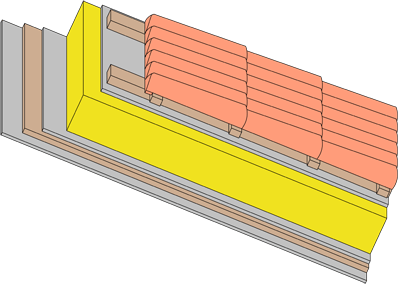Geprüftes/zugelassenes Bauteil
pitched roof sdrhzi09a-09
pitched roof timber frame construction, ventilated, with dry lining, not suspended
Building physical assessment
| Fire performance | REI | 30 |
|---|---|---|
|
maximum span = 5 m; maximum load Ed,fi = 2,62 kN/m² (rafter 60/200 without roofing, counter battens and battens)
Classified by HFA Classified by HFA
Fire performance Germany
Classification: F30
Load Ed,fi according to the German certification document
Proof: DIN 4102-4:2016-05, Tabelle 10.19, Zeile 1
|
||
| Thermal performance | U | 0,17 W/(m2K) |
| Diffusion | adequate | |
|
Calculated by TUM
|
||
| Acoustic performance | Rw (C;Ctr) | 54 dB (-1; -7) |
| Ln,w (Cl) | ||
|
Rating by Müller-BBM
|
||
| Mass per unit area | m | 110,7 kg/m2 |
|
Calculation based on gypsum plaster board type DF GKF
|
||
data sheet pitched roof
sdrhzi09a-09 (pdf, 250 KB)
Note
The design of the under-roof construction and of the counter-battens have to be specified according to the roof pitch and the national requirements.
Only for registered members after logging in.


Register of building materials used for this application, cross-section (from outside to inside)
| Thickness [mm] | Building material | Thermal performance | Reaction to fireklasse EN | ||||
|---|---|---|---|---|---|---|---|
| λ | μ min – max | ρ | c | ||||
| A | concrete roof tile or tiled roof | 2100 | A1 | ||||
| B | 30,0 | spruce wood battens (30/50) | 0,120 | 50 | 450 | 1,600 | D |
| C | 50,0 | spruce wood counter battens (Austria: minimum height 50 mm), Germany 30 mm | 0,120 | 50 | 450 | 1,600 | D |
| D | 16,0 | fibreboard (MDF) | 0,140 | 11 | 600 | 1,700 | D |
| E | 240,0 | construction timber (80/..; e=625) | 0,120 | 50 | 450 | 1,600 | D |
| F | 240,0 | Cellulose fibre [040; 50] | 0,040 | 1 | 50 | 2,000 | E |
| G | 15,0 | OSB (sealed with airtight tape) | 0,130 | 200 | 600 | 1,700 | D |
| H | 24,0 | spruce wood cladding with spacing of cladding boards(24/100); a=400 | 0,120 | 50 | 450 | 1,600 | D |
| I | 12,5 | gypsum plaster board type DF or | 0,250 | 10 | 800 | 1,050 | A2 |
| I | 12,5 | gypsum fibre board | 0,320 | 21 | 1000 | 1,100 | A2 |
Ecological rating (per m2 construction area)
Details of sustainability rating...
| Global warming potential | Share of renewable Primary Energy | Resources | |||||||||||
|---|---|---|---|---|---|---|---|---|---|---|---|---|---|
| Lifecycle Phase |
GWP-F [kgCO2Äqv.] |
GWP-B [kgCO2Äqv.] |
GWP-T [kgCO2Äqv.] |
PERE [MJ] |
PERM [MJ] |
PERT [MJ] |
PENRE [MJ] |
PENRM [MJ] |
PENRT [MJ] |
AP [kgSO2Äqv.] |
EP [kgPO4Äqv.] |
ODP [kgR11Äqv.] |
POCP [kgEthenÄqv.] |
| A1 - A3 | 29,017 | -72,467 | -43,450 | 112,370 | 753,355 | 865,725 | 396,056 | 30,095 | 426,151 | 0,119 | 0,051 | 2.4015412E-6 | 0,021 |
Details of sustainability rating...
| Resources | |||||||||||
|---|---|---|---|---|---|---|---|---|---|---|---|
| Lifecycle Phase |
GWP [kgCO2Äqv.] |
AP [kgSO2Äqv.] |
EP [kgPO4Äqv.] |
ODP [kgR11Äqv.] |
POCP [kgEthenÄqv.] |
PERE [MJ] |
PERM [MJ] |
PERT [MJ] |
PENRE [MJ] |
PENRM [MJ] |
PENRT [MJ] |
| A1 - A3 | 0,000 | 0,000 | 0,000 | 0,000 | 0,000 | 0,000 | 0,000 | 0,000 | 0,000 | 0,000 | |
| C1 - C4 | 0,000 | 0,000 | 0,000 | 0,000 | 0,000 | 0,000 | 0,000 | 0,000 | 0,000 | 0,000 | |
| A1 - C4 | 0,000 | 0,000 | 0,000 | 0,000 | 0,000 | 0,000 | 0,000 | 0,000 | 0,000 | 0,000 | |
Last update 02.08.2023/hfa.eco2soft